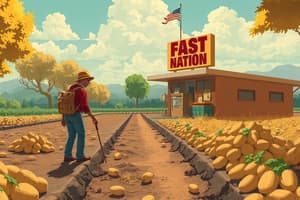Podcast
Questions and Answers
What is the primary purpose of proper tillage in soil preparation for potato farming?
What is the primary purpose of proper tillage in soil preparation for potato farming?
- To reduce aeration
- To improve aeration (correct)
- To decrease microbiological activity
- To increase soil compaction
Which nutrient is essential for supporting robust growth in potatoes at all stages of development?
Which nutrient is essential for supporting robust growth in potatoes at all stages of development?
- Iron
- Phosphorus (correct)
- Magnesium
- Calcium
What is the optimal pH range for soil when preparing for potato farming?
What is the optimal pH range for soil when preparing for potato farming?
- 5.8 - 6.2 (correct)
- 3.0 - 4.0
- 7.0 - 8.0
- 9.5 - 10.0
Which planting method involves sowing small tubers called 'seed pieces'?
Which planting method involves sowing small tubers called 'seed pieces'?
Why do transplants generally mature faster than those planted through direct seeding in potato farming?
Why do transplants generally mature faster than those planted through direct seeding in potato farming?
Which pest control measure is commonly used in potato farming to protect the crop?
Which pest control measure is commonly used in potato farming to protect the crop?
What is the primary benefit of using drip irrigation over furrow irrigation for potatoes?
What is the primary benefit of using drip irrigation over furrow irrigation for potatoes?
Why is integrated pest management (IPM) important for potato cultivation?
Why is integrated pest management (IPM) important for potato cultivation?
Which harvesting method is commonly used for potatoes to ensure higher quality produce suitable for both fresh consumption and processing needs?
Which harvesting method is commonly used for potatoes to ensure higher quality produce suitable for both fresh consumption and processing needs?
What is the main purpose of storing potatoes on straw beds or plastic mounds aboveground after harvesting?
What is the main purpose of storing potatoes on straw beds or plastic mounds aboveground after harvesting?
Which technique is NOT commonly used for preventing pests in potato cultivation?
Which technique is NOT commonly used for preventing pests in potato cultivation?
How does consistent moisture availability during crucial times benefit potato cultivation?
How does consistent moisture availability during crucial times benefit potato cultivation?
Flashcards are hidden until you start studying
Study Notes
Potato Production Overview
Potatoes have been a staple food for countless cultures around the world due to their versatility and nutritional benefits. Understanding how potatoes are produced offers valuable insights into this vital agricultural industry. In this exploration of potato farming, we'll delve into critical aspects such as soil prep, planting methods, irrigation strategies, pest control measures, and harvesting practices.
Soil Preparation
Before any spuds break ground, it's essential to ensure healthy soil conditions through proper tillage, fertilization, and amendments. Tillage exposes new surface areas, improving aeration while reducing compaction. Fertilizers containing nitrogen, phosphorus, and potassium support robust growth throughout all stages of development. Organic matter like animal manure, crop residues, and compost boost organic matter levels, improve water retention, and increase microbiological activity within the soil. Optimal pH range is between 5.8 and 6.2.
Planting Methods
There are two primary ways to introduce young potatoes into fields: direct seeding and transplanting established plants. Direct seeding involves sowing small tubers called 'seed pieces.' These generally take longer to mature since they require time to develop roots before sprouting. Transplants, however, begin life under controlled environments where growers can regulate temperature, humidity, light, and nutrition. When ready, these vigorous plants are transferred directly to the field for faster maturity rates.
Irrigation Techniques
Consistent moisture availability during crucial times is necessary for high yields. Rainfall isn't always reliable, so supplemental irrigation comes into play. Both furrow and drip systems deliver water straight to the root zone by utilizing gravity or low-pressure emitters, respectively. Furrows allow more efficient application over large areas, while drip irrigations minimize evaporative losses, reduce weed competition, and conserve water resources.
Pest Management
Just like any other crops, potatoes must combat various pests ranging from insects, nematodes, diseases, and rodents. Integrated pest management (IPM) combines preventive cultural practices with biological, chemical, and mechanical approaches tailored to specific problems. Some common IPM tactics for potatoes include crop rotation, resistant varieties, monitoring, scouting, and targeted applications of bio-controls or conventional chemicals when needed.
Harvesting Practices
Once potatoes reach maturity – usually indicated by flowering in warmer climates or vines dying back in cooler regions – it's time to gather them. Mechanical harvesters, typically employing digging wheels or belts, are commonly used. Efficiently harvested potatoes yield fewer defects, resulting in higher quality produce suitable for both fresh consumption and processing needs. After harvesting, some farmers store potatoes on straw beds or plastic mounds aboveground, whereas others opt for underground storage facilities.
In conclusion, understanding the complexities associated with each phase of potato cultivation enables us to optimize our efforts towards producing better-quality potatoes, ensuring global accessibility to affordable, nutrient-dense foods.
Studying That Suits You
Use AI to generate personalized quizzes and flashcards to suit your learning preferences.




